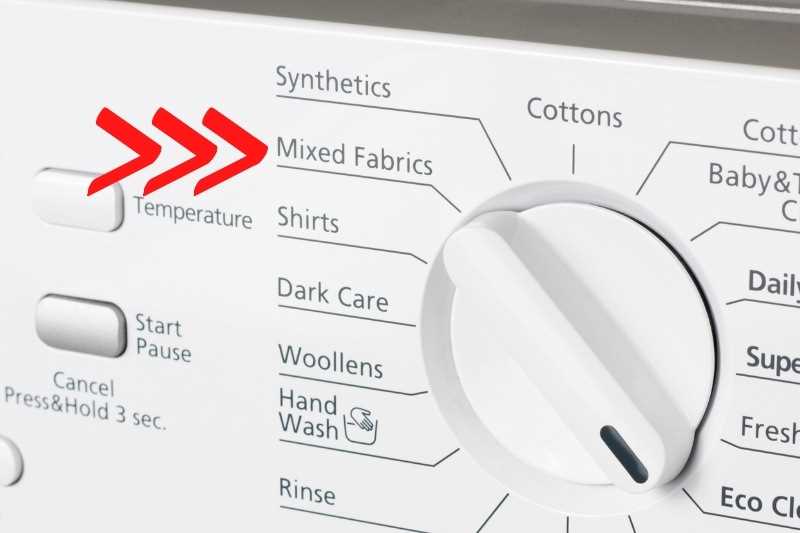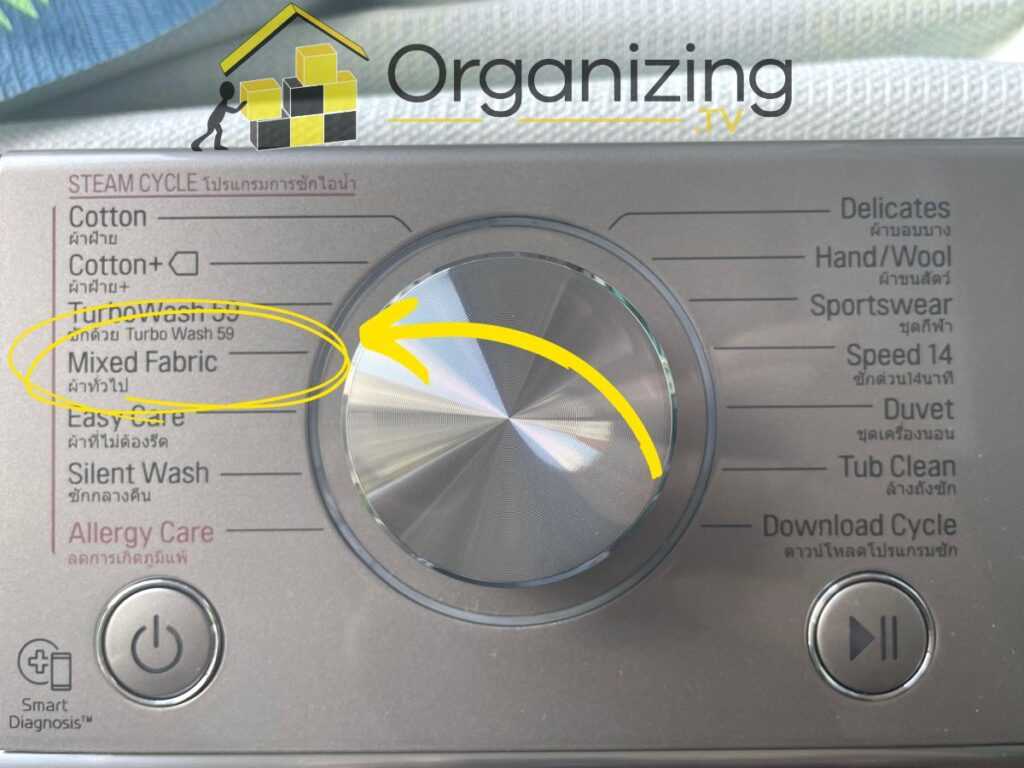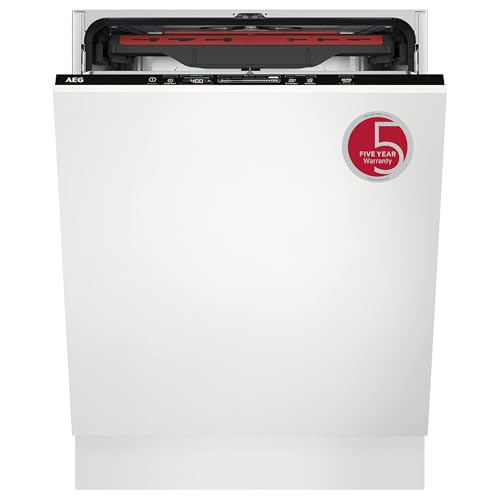




When it comes to doing laundry, having the right settings on your washing machine can make all the difference. One setting that is often overlooked is the mixed load setting. This setting is designed to handle a combination of different fabrics and colors all in one load, saving you time and energy.
The mixed load setting works by adjusting the water temperature, spin speed, and cycle length to accommodate the needs of different types of fabrics. For example, it may use a cooler water temperature for delicate items, while using a higher spin speed for heavier items. This ensures that each item in the load is properly cleaned and cared for.
Using the mixed load setting can also help preserve the vibrancy of your clothes. By separating your laundry into different loads based on color or fabric, you may be exposing them to unnecessary wear and tear. The mixed load setting allows you to wash a variety of items together, reducing the number of loads you need to do and extending the life of your clothing.
“Using the mixed load setting can help save both time and energy.”
However, it is important to note that not all items may be suitable for the mixed load setting. Certain delicate or heavily soiled items may still require separate treatment. For these items, it is best to consult the garment care labels or the manufacturer’s instructions.
In conclusion, understanding and utilizing the mixed load setting on your washing machine can greatly simplify your laundry routine. With this setting, you can safely and efficiently wash a variety of fabrics and colors together, saving you time, energy, and money in the process. So next time you load up your washing machine, give the mixed load setting a try and experience the benefits for yourself.
How to Use the Mixed Load Setting on Your Washing Machine
The mixed load setting on your washing machine is a versatile option that allows you to wash a combination of different fabrics and colors in the same load. This setting is ideal for when you have a variety of laundry items that need to be cleaned, but don’t require separate cycles.
Step 1: Sort Your Laundry
Before using the mixed load setting, it’s important to sort your laundry items. Separate them based on fabric type (e.g., cotton, synthetic, delicate) and color (e.g., light, dark, whites). This will help ensure that each item receives the appropriate care during the wash cycle.
Step 2: Load the Machine
Once you have sorted your laundry, load the machine with the clothes and other items you wish to wash. Be careful not to overload the machine, as this can affect the cleaning performance and the efficiency of the wash cycle.
Step 3: Add Detergent
Add the appropriate amount of detergent to the detergent dispenser or directly into the drum, following the manufacturer’s instructions. Use a detergent that is suitable for mixed loads and compatible with the fabrics you are washing.
Step 4: Select the Mixed Load Setting
On your washing machine, locate the control panel. Look for the setting that is specifically labeled for mixed loads. This setting may also be indicated by a mixed load icon or symbol. Select this setting to activate the mixed load cycle.
Step 5: Adjust Temperature and Spin Speed
Depending on the fabrics and colors in your mixed load, you may need to adjust the temperature and spin speed settings. For example, use a lower temperature and gentler spin for delicate items, and a higher temperature and faster spin for more durable fabrics.
Step 6: Start the Wash Cycle
Once you have made the necessary adjustments, press the start button to begin the wash cycle. The machine will now proceed to wash your mixed load using the selected settings.
Step 7: Remove and Dry Your Laundry

After the wash cycle is complete, carefully remove your laundry from the machine. If necessary, separate any items that require different drying methods (e.g., air drying, tumble drying). Follow the care instructions on the garment tags to ensure proper drying and maintenance.
Using the mixed load setting on your washing machine allows you to efficiently clean a variety of laundry items in one cycle. This feature saves you time and energy, while still ensuring that each item is properly cared for.
How Does the Mixed Load Setting Work?
The mixed load setting on your washing machine is designed to allow you to wash a combination of different fabrics and colors in one load. It provides a convenient option for handling a variety of laundry items without the need to separate them into different loads.
When you select the mixed load setting, the washing machine adjusts the water temperature, water level, and agitation intensity to accommodate the different fabrics and colors in the load.
Water Temperature
The mixed load setting typically uses a warm or cold water temperature to protect delicate fabrics and prevent color bleeding. Warm water helps to remove stains and odors, while cold water is gentler on fabrics and helps to prevent shrinkage.
Water Level
The water level for a mixed load is usually determined by the weight of the laundry items. The washing machine will automatically adjust the water level to ensure that the load is properly saturated and has enough water to effectively clean the clothes.
Agitation Intensity
The mixed load setting also adjusts the agitation intensity to avoid damaging delicate fabrics. It uses a gentler agitation motion to prevent excessive rubbing and stretching of the clothes, while still ensuring thorough cleaning.
Tips for Using the Mixed Load Setting
- Sort your laundry by color and fabric type to ensure that all items in the load are suitable for washing together.
- Avoid overloading the washing machine to ensure that the clothes have enough space to move freely and get properly cleaned.
- Use a mild detergent suitable for a variety of fabrics to prevent damage or discoloration.
- Check the garment labels for any special washing instructions and follow them accordingly, even when using the mixed load setting.
By understanding how the mixed load setting works and following these tips, you can effectively use this feature to save time and energy on laundry day while still ensuring that all your clothes come out clean and in good condition.
Benefits of Using the Mixed Load Setting
The mixed load setting on your washing machine has several benefits that make it a versatile and convenient option for doing laundry. Here are some of the advantages of using the mixed load setting:
1. Time-Saving
One of the biggest benefits of using the mixed load setting is that it can save you time. Instead of sorting your laundry into separate loads based on fabric type or color, you can simply combine different types of clothes together. This means fewer loads to wash, which translates to less time spent on laundry chores.
2. Energy Efficiency

By combining different types of clothes in one load, you’ll be able to maximize the efficiency of your washing machine. The mixed load setting ensures that the machine uses the appropriate amount of water, detergent, and energy required to clean the clothes effectively. This helps to reduce energy consumption and lower your utility bills.
3. Versatility

The mixed load setting allows you to wash a variety of items at the same time. Whether you have a few delicate garments that require gentle care or heavily soiled towels that need a deep clean, the mixed load setting can handle it all. It gives you the flexibility to wash different fabrics, colors, and levels of dirtiness together, without compromising the quality of the wash.
4. Convenience
Using the mixed load setting is convenient because it eliminates the need for separate loads. You don’t have to spend time sorting and categorizing your laundry, making the process less cumbersome and more straightforward. This is especially beneficial for busy individuals who want to streamline their laundry routine and get their clothes clean quickly.
5. Protects Delicate Items
The mixed load setting is designed to be gentle on delicate items while still effectively cleaning them. It uses a combination of lower agitation and reduced spin speed to minimize the risk of damage to fragile fabrics. This means you can safely wash your delicate clothes along with sturdier items without worrying about tears or stretching.
The mixed load setting on your washing machine offers numerous benefits, including time-saving convenience, energy efficiency, versatility, and protection for delicate items. Take advantage of this feature to simplify your laundry routine and achieve optimal cleanliness for all types of clothing.
Tips for Using the Mixed Load Setting
Here are some helpful tips for using the mixed load setting on your washing machine:
- Sort your clothes: Before using the mixed load setting, make sure to sort your clothes properly. Separate them into different piles based on their fabric type and color. This will help prevent any damage or color bleeding during the wash.
- Load the machine correctly: When loading the machine with a mixed load, it’s important to distribute the clothes evenly. Place heavy items at the bottom and lighter items on top to ensure balanced washing and spinning.
- Use the recommended detergent: Choose a detergent specifically designed for mixed loads. These detergents are formulated to effectively clean different types of fabrics without causing any damage or discoloration.
- Select the appropriate cycle: Depending on the types of fabrics in your mixed load, select the appropriate wash cycle. Some washing machines have specific mixed load settings that you can choose from. Otherwise, opt for a gentle or delicate cycle to protect your clothes.
- Avoid overcrowding: It’s important not to overload your washing machine, especially when using the mixed load setting. Overcrowding can lead to ineffective cleaning and excessive wear and tear on your clothes.
- Follow garment care instructions: Always check the care labels on your clothes for any specific washing instructions. Some garments may require special attention or need to be hand washed instead of being included in a mixed load.
- Separate heavily soiled items: If you have heavily soiled items in your mixed load, consider pre-treating them or washing them separately. This will help prevent any dirt or stains from transferring onto the rest of the clothes.
- Check for left-behind items: Before starting the wash cycle, double-check that you haven’t left any small items, like socks or accessories, behind. These items can cause blockages and disrupt the washing process.
- Remove clothes promptly: Once the wash cycle is complete, remove your clothes from the washing machine promptly. Leaving them inside for too long can lead to a musty smell or even mold growth.
By following these tips, you can make the most of the mixed load setting on your washing machine and ensure that your clothes come out clean and undamaged every time.
Common Mistakes to Avoid with the Mixed Load Setting
1. Overloading the machine
One common mistake that people make when using the mixed load setting on their washing machine is overloading the machine. While it can be tempting to put as many clothes as possible into one load, overloading the machine can lead to poor cleaning results and potential damage to both your clothes and the machine.
2. Mixing incompatible fabrics
Another mistake to avoid when using the mixed load setting is mixing incompatible fabrics. Some fabrics require different washing cycles and water temperatures to maintain their quality. For example, mixing delicate fabrics with heavy-duty items like jeans can lead to damage or shrinking of the delicate garments.
3. Neglecting to sort by color
While the mixed load setting allows you to wash different colored items together, it’s essential to sort your clothes by color to avoid color bleeding. Mixing dark and light colors can result in dye transfer from darker items to lighter ones, leading to discolored clothes. Remember to wash similar colors together to prevent this issue.
4. Using the wrong detergent
Using the wrong detergent can also be a common mistake when using the mixed load setting. Some fabrics require specific detergents or special additives to remove stains or maintain their quality. Using the wrong detergent can result in ineffective cleaning or even damage to your clothes.
5. Forgetting to check care labels

Every garment comes with a care label that provides essential instructions for washing. Neglecting to check these care labels before washing a mixed load can lead to mistakes and potential damage. Always check the care labels on your clothes to ensure they are suitable for washing together and follow any specific instructions.
6. Ignoring the weight limit of the machine
Each washing machine has a weight limit for the amount of clothes it can handle. Ignoring this weight limit can result in excessive strain on the machine’s motor and may lead to breakdowns or malfunctions. Be sure to check and follow the weight limit recommendations for your washing machine to avoid any issues.
7. Not using the right wash settings

Lastly, another mistake to avoid is not using the right wash settings for your mixed load. Different fabrics and soil levels require specific wash settings for optimal cleaning results. Make sure to select the appropriate wash cycle, water temperature, and spin speed for your mixed load to ensure thorough cleaning.
By avoiding these common mistakes, you can maximize the effectiveness of the mixed load setting on your washing machine and keep your clothes in the best condition possible.
FAQ
What is the purpose of the mixed load setting on my washing machine?
The mixed load setting on your washing machine is designed to accommodate a variety of fabrics and colours in one load. It allows you to wash different types of clothing together without worrying about potential damage or bleeding of colours.
Can I wash delicate items on the mixed load setting?
Yes, you can wash delicate items on the mixed load setting. However, it’s important to check the garment labels to ensure they are suitable for machine washing. If the delicate items have specific care instructions, it’s best to follow those instead of using the mixed load setting.
Is the mixed load setting suitable for heavily soiled clothes?
The mixed load setting can be used for lightly soiled or moderately soiled clothes. For heavily soiled clothes, it is recommended to use a separate wash cycle or pre-treat the stains before using the mixed load setting. This will ensure that the heavily soiled clothes are cleaned effectively.
Can I wash white and coloured clothes together on the mixed load setting?
Yes, you can wash white and coloured clothes together on the mixed load setting. However, it’s important to separate heavily soiled items, as they may require a different washing cycle. Additionally, make sure to use a suitable detergent that is safe for both white and coloured fabrics to avoid any colour transfer.












